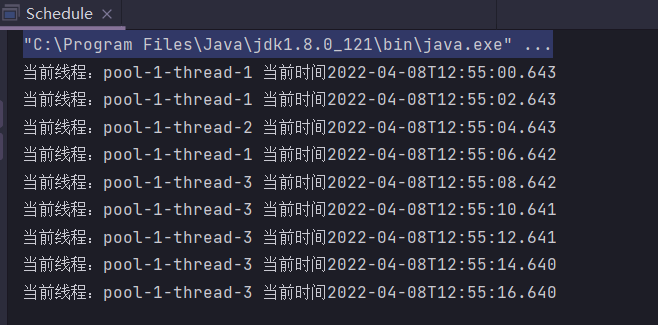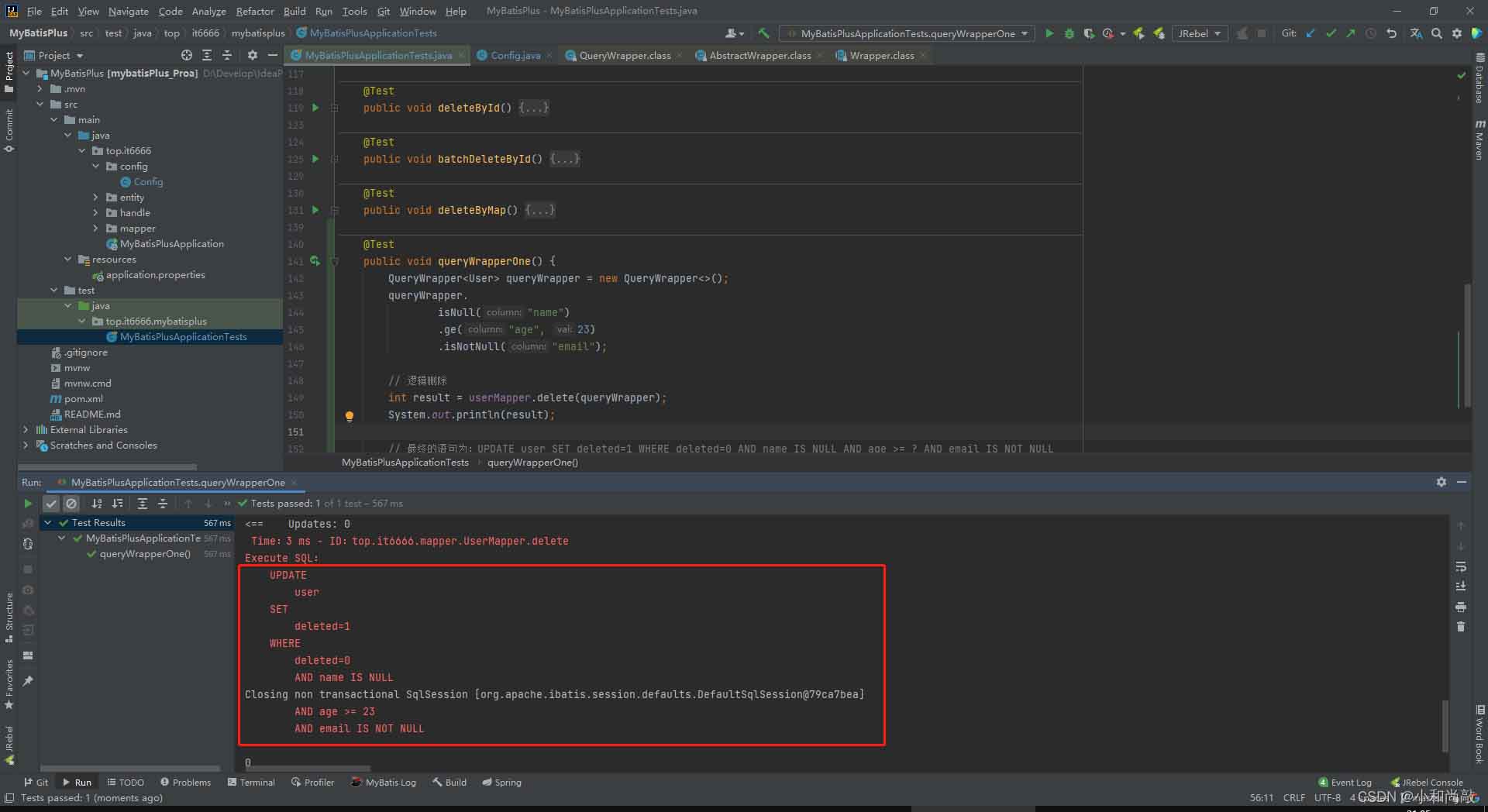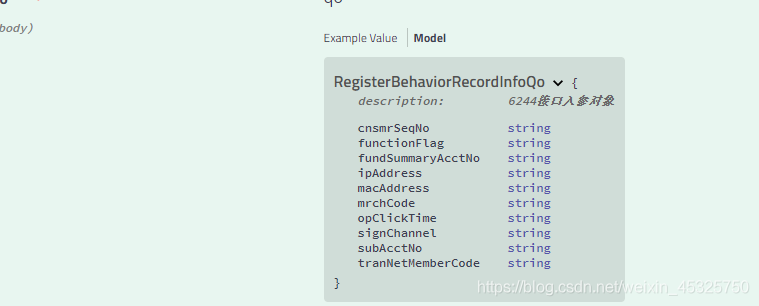详解SpringBoot如何实现整合微信登录 目录 1.准备工作 1.1 获取微信登录凭证 1.2 配置文件 1.3 添加依赖 1.4 创建读取公共常量的工具类 1.5 HttpClient工具类 2.实现微信登录 2.1 具体流程 2.2 生成微信扫描的二维码(请求CODE) 2.3 回调 1.准备工作 1.1 获取微信
目录
- 1.准备工作
- 1.1 获取微信登录凭证
- 1.2 配置文件
- 1.3 添加依赖
- 1.4 创建读取公共常量的工具类
- 1.5 HttpClient工具类
- 2.实现微信登录
- 2.1 具体流程
- 2.2 生成微信扫描的二维码(请求CODE)
- 2.3 回调
1.准备工作
1.1 获取微信登录凭证
前往官网微信开放平台 (qq.com),完成以下步骤:
1.注册
2.邮箱激活
3.完善开发者资料
4.开发者资质认证
5.创建网站应用
1.2 配置文件
在配置文件application.properties添加相关配置信息:
# 微信开放平台 appid
wx.open.app_id=你的appid
# 微信开放平台 appsecret
wx.open.app_secret=你的appsecret
# 微信开放平台重定向url
wx.open.redirect_url=http://81/api/ucenter/wx/callback
1.3 添加依赖
<!--httpclient-->
<dependency>
<groupId>org.apache.httpcomponents</groupId>
<artifactId>httpclient</artifactId>
</dependency>
<!--commons-io-->
<dependency>
<groupId>commons-io</groupId>
<artifactId>commons-io</artifactId>
</dependency>
<!--gson-->
<dependency>
<groupId>com.google.code.gson</groupId>
<artifactId>gson</artifactId>
</dependency>
1.4 创建读取公共常量的工具类
创建读取公共常量的工具类ConstantWxUtils:
/**
* @author xppll
* @date 2021/12/11 14:39
*/
@Component
public class ConstantWxUtils implements InitializingBean {
@Value("${wx.open.app_id}")
private String appId;
@Value("${wx.open.app_secret}")
private String appSecret;
@Value("${wx.open.redirect_url}")
private String redirectUrl;
public static String WX_OPEN_APP_ID;
public static String WX_OPEN_APP_SECRET;
public static String WX_OPEN_REDIRECT_URL;
@Override
public void afterPropertiesSet() throws Exception {
WX_OPEN_APP_ID = appId;
WX_OPEN_APP_SECRET = appSecret;
WX_OPEN_REDIRECT_URL = redirectUrl;
}
}
1.5 HttpClient工具类
/**
* 依赖的jar包有:commons-lang-2.6.jar、httpclient-4.3.2.jar、httpcore-4.3.1.jar、commons-io-2.4.jar
* @author zhaoyb
*
*/
public class HttpClientUtils {
public static final int connTimeout=10000;
public static final int readTimeout=10000;
public static final String charset="UTF-8";
private static HttpClient client = null;
static {
PoolingHttpClientConnectionManager cm = new PoolingHttpClientConnectionManager();
cm.setMaxTotal(128);
cm.setDefaultMaxPerRoute(128);
client = HttpClients.custom().setConnectionManager(cm).build();
}
public static String postParameters(String url, String parameterStr) throws ConnectTimeoutException, SocketTimeoutException, Exception{
return post(url,parameterStr,"application/x-www-form-urlencoded",charset,connTimeout,readTimeout);
}
public static String postParameters(String url, String parameterStr,String charset, Integer connTimeout, Integer readTimeout) throws ConnectTimeoutException, SocketTimeoutException, Exception{
return post(url,parameterStr,"application/x-www-form-urlencoded",charset,connTimeout,readTimeout);
}
public static String postParameters(String url, Map<String, String> params) throws ConnectTimeoutException,
SocketTimeoutException, Exception {
return postForm(url, params, null, connTimeout, readTimeout);
}
public static String postParameters(String url, Map<String, String> params, Integer connTimeout,Integer readTimeout) throws ConnectTimeoutException,
SocketTimeoutException, Exception {
return postForm(url, params, null, connTimeout, readTimeout);
}
public static String get(String url) throws Exception {
return get(url, charset, null, null);
}
public static String get(String url, String charset) throws Exception {
return get(url, charset, connTimeout, readTimeout);
}
/**
* 发送一个 Post 请求, 使用指定的字符集编码.
*
* @param url
* @param body RequestBody
* @param mimeType 例如 application/xml "application/x-www-form-urlencoded" a=1&b=2&c=3
* @param charset 编码
* @param connTimeout 建立链接超时时间,毫秒.
* @param readTimeout 响应超时时间,毫秒.
* @return ResponseBody, 使用指定的字符集编码.
* @throws ConnectTimeoutException 建立链接超时异常
* @throws SocketTimeoutException 响应超时
* @throws Exception
*/
public static String post(String url, String body, String mimeType,String charset, Integer connTimeout, Integer readTimeout)
throws ConnectTimeoutException, SocketTimeoutException, Exception {
HttpClient client = null;
HttpPost post = new HttpPost(url);
String result = "";
try {
if (StringUtils.isNotBlank(body)) {
HttpEntity entity = new StringEntity(body, ContentType.create(mimeType, charset));
post.setEntity(entity);
}
// 设置参数
Builder customReqConf = RequestConfig.custom();
if (connTimeout != null) {
customReqConf.setConnectTimeout(connTimeout);
}
if (readTimeout != null) {
customReqConf.setSocketTimeout(readTimeout);
}
post.setConfig(customReqConf.build());
HttpResponse res;
if (url.startsWith("https")) {
// 执行 Https 请求.
client = createSSLInsecureClient();
res = client.execute(post);
} else {
// 执行 Http 请求.
client = HttpClientUtils.client;
res = client.execute(post);
}
result = IOUtils.toString(res.getEntity().getContent(), charset);
} finally {
post.releaseConnection();
if (url.startsWith("https") && client != null&& client instanceof CloseableHttpClient) {
((CloseableHttpClient) client).close();
}
}
return result;
}
/**
* 提交form表单
*
* @param url
* @param params
* @param connTimeout
* @param readTimeout
* @return
* @throws ConnectTimeoutException
* @throws SocketTimeoutException
* @throws Exception
*/
public static String postForm(String url, Map<String, String> params, Map<String, String> headers, Integer connTimeout,Integer readTimeout) throws ConnectTimeoutException,
SocketTimeoutException, Exception {
HttpClient client = null;
HttpPost post = new HttpPost(url);
try {
if (params != null && !params.isEmpty()) {
List<NameValuePair> formParams = new ArrayList<NameValuePair>();
Set<Entry<String, String>> entrySet = params.entrySet();
for (Entry<String, String> entry : entrySet) {
formParams.add(new BasicNameValuePair(entry.getKey(), entry.getValue()));
}
UrlEncodedFormEntity entity = new UrlEncodedFormEntity(formParams, Consts.UTF_8);
post.setEntity(entity);
}
if (headers != null && !headers.isEmpty()) {
for (Entry<String, String> entry : headers.entrySet()) {
post.addHeader(entry.getKey(), entry.getValue());
}
}
// 设置参数
Builder customReqConf = RequestConfig.custom();
if (connTimeout != null) {
customReqConf.setConnectTimeout(connTimeout);
}
if (readTimeout != null) {
customReqConf.setSocketTimeout(readTimeout);
}
post.setConfig(customReqConf.build());
HttpResponse res = null;
if (url.startsWith("https")) {
// 执行 Https 请求.
client = createSSLInsecureClient();
res = client.execute(post);
} else {
// 执行 Http 请求.
client = HttpClientUtils.client;
res = client.execute(post);
}
return IOUtils.toString(res.getEntity().getContent(), "UTF-8");
} finally {
post.releaseConnection();
if (url.startsWith("https") && client != null
&& client instanceof CloseableHttpClient) {
((CloseableHttpClient) client).close();
}
}
}
/**
* 发送一个 GET 请求
*
* @param url
* @param charset
* @param connTimeout 建立链接超时时间,毫秒.
* @param readTimeout 响应超时时间,毫秒.
* @return
* @throws ConnectTimeoutException 建立链接超时
* @throws SocketTimeoutException 响应超时
* @throws Exception
*/
public static String get(String url, String charset, Integer connTimeout,Integer readTimeout)
throws ConnectTimeoutException,SocketTimeoutException, Exception {
HttpClient client = null;
HttpGet get = new HttpGet(url);
String result = "";
try {
// 设置参数
Builder customReqConf = RequestConfig.custom();
if (connTimeout != null) {
customReqConf.setConnectTimeout(connTimeout);
}
if (readTimeout != null) {
customReqConf.setSocketTimeout(readTimeout);
}
get.setConfig(customReqConf.build());
HttpResponse res = null;
if (url.startsWith("https")) {
// 执行 Https 请求.
client = createSSLInsecureClient();
res = client.execute(get);
} else {
// 执行 Http 请求.
client = HttpClientUtils.client;
res = client.execute(get);
}
result = IOUtils.toString(res.getEntity().getContent(), charset);
} finally {
get.releaseConnection();
if (url.startsWith("https") && client != null && client instanceof CloseableHttpClient) {
((CloseableHttpClient) client).close();
}
}
return result;
}
/**
* 从 response 里获取 charset
*
* @param ressponse
* @return
*/
@SuppressWarnings("unused")
private static String getCharsetFromResponse(HttpResponse ressponse) {
// Content-Type:text/html; charset=GBK
if (ressponse.getEntity() != null && ressponse.getEntity().getContentType() != null && ressponse.getEntity().getContentType().getValue() != null) {
String contentType = ressponse.getEntity().getContentType().getValue();
if (contentType.contains("charset=")) {
return contentType.substring(contentType.indexOf("charset=") + 8);
}
}
return null;
}
/**
* 创建 SSL连接
* @return
* @throws GeneralSecurityException
*/
private static CloseableHttpClient createSSLInsecureClient() throws GeneralSecurityException {
try {
SSLContext sslContext = new SSLContextBuilder().loadTrustMaterial(null, new TrustStrategy() {
public boolean isTrusted(X509Certificate[] chain,String authType) throws CertificateException {
return true;
}
}).build();
SSLConnectionSocketFactory sslsf = new SSLConnectionSocketFactory(sslContext, new X509HostnameVerifier() {
@Override
public boolean verify(String arg0, SSLSession arg1) {
return true;
}
@Override
public void verify(String host, SSLSocket ssl)
throws IOException {
}
@Override
public void verify(String host, X509Certificate cert)
throws SSLException {
}
@Override
public void verify(String host, String[] cns,
String[] subjectAlts) throws SSLException {
}
});
return HttpClients.custom().setSSLSocketFactory(sslsf).build();
} catch (GeneralSecurityException e) {
throw e;
}
}
public static void main(String[] args) {
try {
String str= post("https://localhost:443/ssl/test.shtml","name=12&page=34","application/x-www-form-urlencoded", "UTF-8", 10000, 10000);
//String str= get("https://localhost:443/ssl/test.shtml?name=12&page=34","GBK");
/*Map<String,String> map = new HashMap<String,String>();
map.put("name", "111");
map.put("page", "222");
String str= postForm("https://localhost:443/ssl/test.shtml",map,null, 10000, 10000);*/
System.out.println(str);
} catch (ConnectTimeoutException e) {
// TODO Auto-generated catch block
e.printStackTrace();
} catch (SocketTimeoutException e) {
// TODO Auto-generated catch block
e.printStackTrace();
} catch (Exception e) {
// TODO Auto-generated catch block
e.printStackTrace();
}
}
}
2.实现微信登录
可以参考官方文档:[网站应用微信登录开发指南](准备工作 | 微信开放文档 (qq.com))
2.1 具体流程
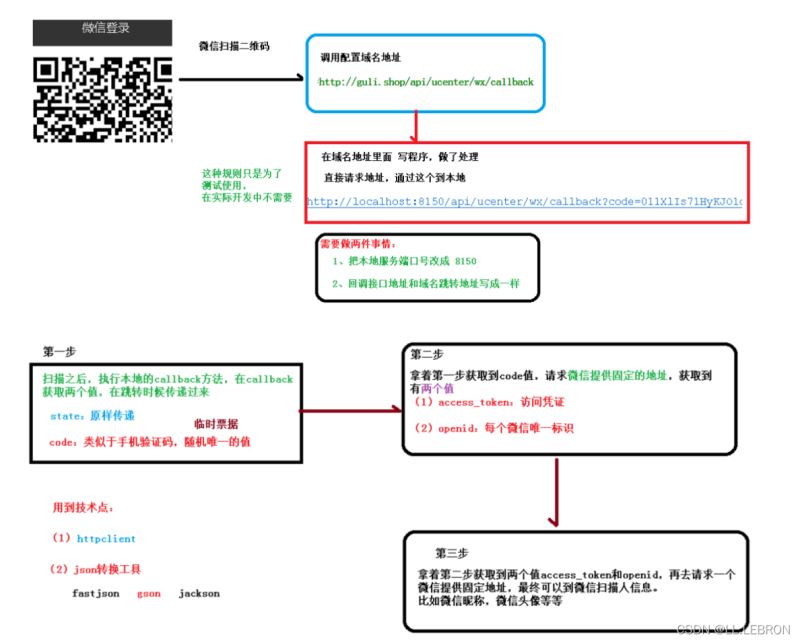
- 第三方发起微信授权登录请求,微信用户允许授权第三方应用后,微信会拉起应用或重定向到第三方网站,并且带上授权临时票据code参数
- 通过code参数加上AppID和AppSecret等,通过API换取access_token
- 通过access_token进行接口调用,获取用户基本数据资源或帮助用户实现基本操作
获取access_token时序图:
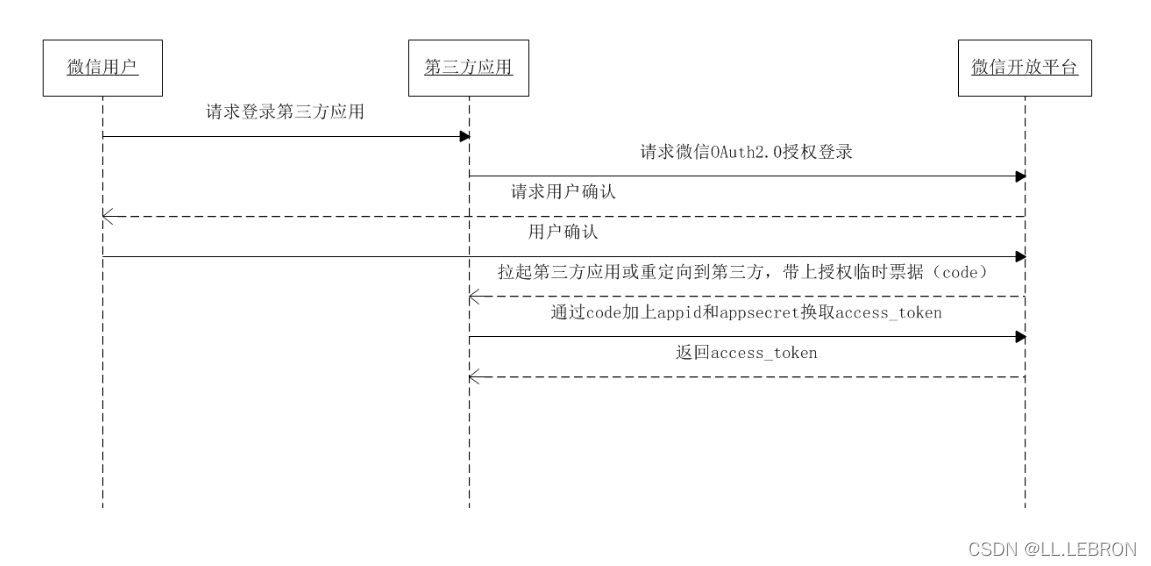
2.2 生成微信扫描的二维码(请求CODE)
controller层:
/**
* @author xppll
* @date 2021/12/11 14:48
*/
@CrossOrigin
@Controller
@RequestMapping("/api/ucenter/wx")
public class WxApiController {
@Autowired
private UcenterMemberService memberService;
/**
* 生成微信扫描二维码
* @return 定向到请求微信地址
*/
@GetMapping("login")
public String getWxCode() {
//微信开放平台授权baseUrl
String baseUrl = "https://open.weixin.qq.com/connect/qrconnect" +
"?appid=%s" +
"&redirect_uri=%s" +
"&response_type=code" +
"&scope=snsapi_login" +
"&state=%s" +
"#wechat_redirect";
//对redirect_url进行URLEncoder编码
String redirectUrl = ConstantWxUtils.WX_OPEN_REDIRECT_URL;
try {
redirectUrl = URLEncoder.encode(redirectUrl, "UTF-8");
} catch (UnsupportedEncodingException e) {
throw new GuliException(20001, e.getMessage());
}
//设置%s的值
String url = String.format(
baseUrl,
ConstantWxUtils.WX_OPEN_APP_ID,
redirectUrl,
"atguigu"
);
//重定向到请求微信地址
return "redirect:" + url;
}
}
访问:http://localhost:8160/api/ucenter/wx/login
访问授权url后会得到一个微信登录二维码:

用户扫描二维码会看到确认登录的页面:
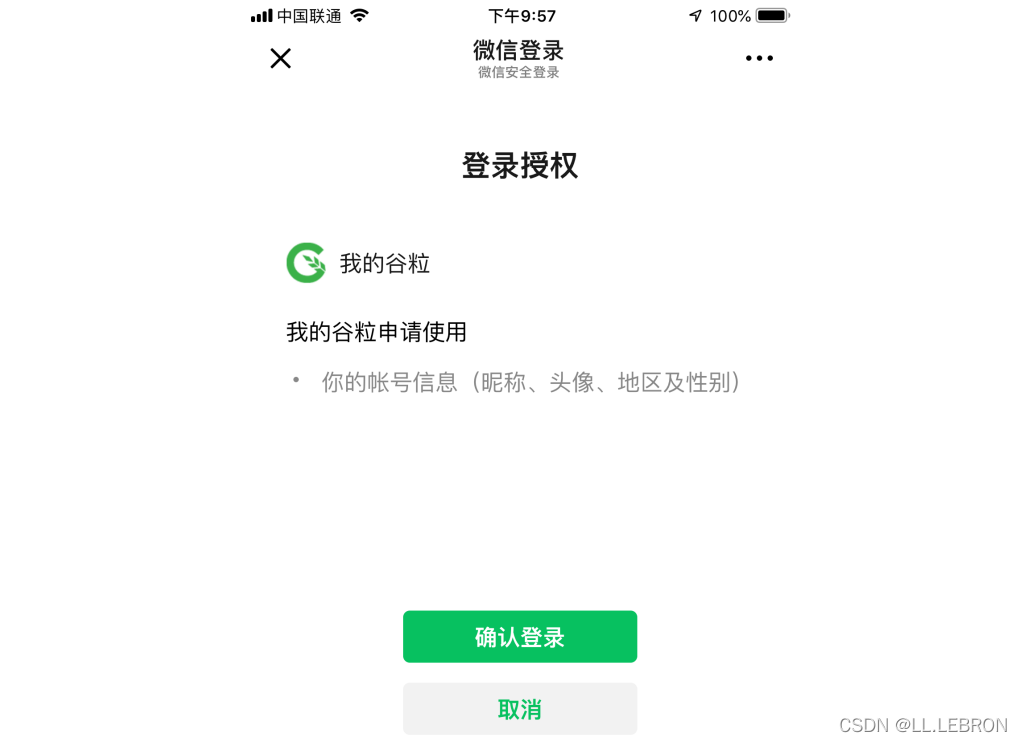
用户点击“确认登录”后,微信服务器会向谷粒学院的业务服务器发起回调,因此接下来我们需要开发回调controller
2.3 回调
具体分几步:
1.通过code获取access_token
https://api.weixin.qq.com/sns/oauth2/access_token?appid=APPID&secret=SECRET&code=CODE&grant_type=authorization_code
| 参数 | 是否必须 | 说明 |
|---|---|---|
| appid | 是 | 应用唯一标识,在微信开放平台提交应用审核通过后获得 |
| secret | 是 | 应用密钥AppSecret,在微信开放平台提交应用审核通过后获得 |
| code | 是 | 填写第一步获取的code参数 |
| grant_type | 是 | 填authorization_code |
2.从返回结果获取两个值access_token、openid
3.通过openid查询数据库判断该用户是不是第一次登录
4.如果是第一次登录,根据access_token和openid再去访问微信的资源服务器,获取用户信息,存入数据库
5.使用jwt根据member对象生成token字符串,最后返回首页面,通过路径传递token字符串
/**
* 获取扫描人信息,添加数据
* @param code 类似于手机验证码,随机唯一的值
* @param state 用于保持请求和回调的状态,授权请求后原样带回给第三方
* @return
*/
@GetMapping("callback")
public String callback(String code, String state) {
try {
//获取code值,临时票据类似于验证码
//拿着code请求微信固定的地址,得到两个值
//1.向认证服务器发送请求换取access_token
String baseAccessTokenUrl =
"https://api.weixin.qq.com/sns/oauth2/access_token" +
"?appid=%s" +
"&secret=%s" +
"&code=%s" +
"&grant_type=authorization_code";
//拼接三个参数:id 密钥 和 code值
String accessTokenUrl = String.format(
baseAccessTokenUrl,
ConstantWxUtils.WX_OPEN_APP_ID,
ConstantWxUtils.WX_OPEN_APP_SECRET,
code
);
//2.请求拼接好的地址,得到返回的两个值access_token和openid
//使用httpclient发送请求,得到返回结果(json形式的字符串)
String accessTokenInfo = HttpClientUtils.get(accessTokenUrl);
//从accessTokenInfo字符串获取两个值access_token、openid
//把accessTokenInfo字符串转换为map集合,根据map里面的key获取值
//这里使用json转换工具Gson
Gson gson = new Gson();
HashMap accessTokenMap = gson.fromJson(accessTokenInfo, HashMap.class);
String access_token = (String) accessTokenMap.get("access_token");
String openid = (String) accessTokenMap.get("openid");
//3.判断该用户是不是第一次扫码登录
//通过openid判断
UcenterMember member = memberService.getOpenIdMember(openid);
//4.只有第一次登录才获取信息
if (member == null) {
//根据access_token和openid再去访问微信的资源服务器,获取用户信息
String baseUserInfoUrl = "https://api.weixin.qq.com/sns/userinfo" +
"?access_token=%s" +
"&openid=%s";
String userInfoUrl = String.format(
baseUserInfoUrl,
access_token,
openid
);
//发送请求,得到用户信息
String userInfo = HttpClientUtils.get(userInfoUrl);
System.out.println(userInfo);
//将用户信息存入数据库
//把json转换为map
HashMap userInfoMap = gson.fromJson(userInfo, HashMap.class);
//得到nickname
String nickname = (String) userInfoMap.get("nickname");
//得到微信头像avatar
String headimgurl = (String) userInfoMap.get("headimgurl");
member = new UcenterMember();
member.setOpenid(openid);
member.setNickname(nickname);
member.setAvatar(headimgurl);
memberService.save(member);
}
//5.使用jwt根据member对象生成token字符串
String jwtToken = JwtUtils.getJwtToken(member.getId(), member.getNickname());
//最后返回首页面,通过路径传递token字符串
return "redirect:http://localhost:3000?token=" + jwtToken;
} catch (Exception e) {
throw new GuliException(20001, "微信登录失败");
}
}
判断该用户是不是第一次扫码登录
以上就是详解SpringBoot如何实现整合微信登录的详细内容,更多关于SpringBoot整合微信登录的资料请关注我们其它相关文章!
本文标题为:详解SpringBoot如何实现整合微信登录


基础教程推荐
- Java编写实现窗体程序显示日历 2023-01-02
- JavaWeb 实现验证码功能(demo) 2024-04-14
- 使用Java和WebSocket实现网页聊天室实例代码 2024-02-25
- 是否适合从javabean类更新数据库? 2023-11-04
- Java+mysql实现学籍管理系统 2023-03-16
- Java中EnvironmentAware 接口的作用 2023-01-23
- springboot下使用shiro自定义filter的个人经验分享 2024-02-27
- JSP 动态树的实现 2023-12-17
- 运用El表达式截取字符串/获取list的长度实例 2023-08-01
- 深入理解约瑟夫环的数学优化方法 2024-03-07









